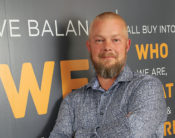Cultivating a positive and productive work culture requires leadership to maximize employee engagement by empowering employees at all levels. Enterprise Minnesota’s Learning to Lead program provides small and medium-sized manufacturing companies the tools they need to create such a culture.
Under the guidance of Enterprise Minnesota’s business growth consultant Abbey Hellickson, Learning to Lead is a series of workshops that shows manufacturers how improving company leadership will better equip them to compete and grow in the difficult workforce market. Companies participate in the program either through referral or from intentional conversations Enterprise Minnesota business developers have with company leadership that suggests the program might be a good fit.
“Enterprise Minnesota focused on building a program around the concept of leadership because of the challenges manufacturing companies have voiced in terms of attracting and retaining talent,” Hellickson says. “Research proves the better-quality leaders we have, the stronger recruitment and retention is within the company and, therefore, the company as a whole is stronger.”
K&G Manufacturing in Faribault, a machine shop with over 75 years of experience in the industry, sent members of its leadership team to participate in the program because developing leaders became just as important to them as product development.
“The environment Abbey Hellickson created with Learning to Lead was extremely interactive,” says Brad Holloway, program manager at K&G. “It forced participants to communicate with each other and learn different communication styles.”
Learning about Social Styles was a key program takeaway for Phil Marik, K&G’s shipping and receiving manager. After discovering his personal Social Style, Marik applied this knowledge within the context of his daily responsibilities.
“I was volun-told to participate in Learning to Lead, but it was really good for me,” Marik says. “Because I interact with machinists on the shop floor, it was important for me to understand my Social Style and the Social Styles of others. I earned more respect for myself and more respect from others.”
The Social Style model also encouraged Chad Bolton, a maintenance manager with K&G, to consider how his behavioral style and preferences contribute to leadership effectiveness. “When we learned about Social Styles, I realized my biggest challenge was with myself,” Bolton says. “Now that I understand how to express myself and share my ideas, I can get more involved in making K&G successful. Our management team listens better now. This class was the start of that change.”
The Action Plan portion of Learning to Lead helped K&G implement an IDEAS (Initiative for Developing Excellence and Success) Team that continues to make on-going progress within the company.
“The IDEAS Team was created to develop other leaders in our organization and bring the company up another level in how we communicate,” Pete Heyer, K&G’s engineering manager, says. “We are the next generation of management in the company, and we needed to prepare for the upcoming changes in leadership. By broadening the base of employees who get involved in projects, we hear ideas from all departments that will keep moving the company forward on a daily basis.” With bi-weekly check-ins, the IDEAS Team reviews each shift and what, if any, changes are needed to keep operations running smoothly.
K&G will continue to send employees to future Learning to Lead sessions. The information and knowledge shared in the program goes hand-in-hand with creating an involved and empowered workforce, Bolton says. “The workplace can’t treat people like a number. Everybody has to be part of the company. It doesn’t matter how much you make or what position you are in; we all need to empower each other and have input.”
For Mike Jensen, president and CEO of Gauthier Industries, Learning to Lead helped his metal fabricator company in Rochester focus on more than just the daily grind of production and hitting the numbers.
“While that’s all well and good, we can’t lose track of developing leaders and investing in the culture of a positive work environment and continuous improvement,” Jensen says. “Today’s society challenges us to have an environment of learning, where new employees can be trained and have an opportunity to succeed. Learning to Lead helped us do just that.”
To build upon the company’s 171 years of experience in management, Jensen sent several members of his leadership team to participate in the program. “Our people are the foundation for Gauthier’s success,” Jensen says. “Providing a culture of skill enhancement and leadership development makes us who we are. And we must transfer that knowledge to others coming up the ranks.”
One team member who participated in the program, Gauthier’s Human Resources Manager Lisa Campbell, used her newly acquired Social Style knowledge to influence her communication skills and interactions with other employees. “I have an Analytical Social Style,” Campbell says. “But I needed to understand the actions of others who may not be part of my Social Style. Thanks to Learning to Lead, I can think beyond my style and better understand what employees need.”
“The program follow-up is excellent to ensure our leaders continue to apply what they learned,” Jensen says. “Abbey Hellickson and the Enterprise Minnesota leadership team are strongly committed to its success for clients like us.”
Learning to Lead is offered in two models: a multi-session model geared toward small manufacturers scheduled every other week over 12 weeks; or an onsite, single company model where Enterprise Minnesota works directly with the company’s team in-house. Both models are separated into six four-hour sessions and combine self-assessments with lectures and interactive discussion along with five components focused on meeting leadership challenges and filling skill gaps.
Social Style
Social Style, a behavioral assessment of the TRACOM Group, is used to evaluate interpersonal skills and improve leadership performance. There are four Social Styles that represent the different behavioral preferences individuals have: Driving, Expressive, Amiable, and Analytical. Learning to Lead participants first determine their own Social Style to recognize how behavioral styles differ from person to person. This heightened awareness helps transform the way employees’ needs are understood and fulfilled by management.
“When we talk about Social Styles we talk about individual needs within each style,” Hellickson says. “We all have different needs that we are looking to fulfill. By understanding where others are coming from, we can really think about whether we are creating positive or negative interactions in our work environments.”
Hellickson maps out the Social Styles of each participant to show where style gaps are, often confirming leaders gravitate toward employing individuals with Social Styles similar to their own. “It’s often the first time people notice they don’t have anyone on their team of a certain style,” Hellickson says. “This mapping really pushes participants out of their comfort zone to realize every style is valuable and that a healthy work environment will meet the needs of all styles.”
The mapping also stimulates conversation about how each style is perceived. “When participants self-assess their Social Style, they also get information on how others perceive their style,” Hellickson says. “It’s really eye-opening for them.”
Which can lead to stronger recruitment, Hellickson continues. By creating a space an interviewee feels comfortable in, he or she is more likely to consider that work environment a good fit. “You can put a person at ease by thinking about their style during the interview,” Hellickson says. “This way, you meet their needs with their style which truly allows you to see the strengths of the individual and empower them early on.”
Versatility
The work accomplished in the Social Style component is then layered into the second component of the workshops, Versatility. Versatility is another product of TRACOM and measures an individual’s ability to work effectively with co-workers and reveals how personal behavior impacts others.
According to TRACOM’s industry research, manufacturing ranks in the bottom five of all industries for versatility skills. But low performance on interpersonal skills can improve with a better distribution of Social Styles and an increased focus on prioritizing employer/employee relationships.
“It’s about tension management, learning how we focus,” Hellickson says. “Then we can help grow and develop better interpersonal relationships with others within the organization. When we have a better understanding of my behavior, your behavior, and alter those behaviors accordingly, we build stronger interpersonal relationships which lead to stronger relationships in a work environment.”
Learning to Lead participants identify what they can do to alter their behaviors and interactions to better meet the needs of the individual they are interacting with. It also comes down to understanding communication styles and how different people view each other. “It really breaks down the Social Style barriers and creates better communication,” Hellickson says.
Employee Engagement
The third component of better leadership is fostering an engaging work environment. “We know that employee engagement is on us as leaders,” Hellickson says. “Managers lead to 70 percent of the variance on how employees rate their engagement level within organizations. And because employee engagement is lower than we want, the challenge is to figure out how to grow that engagement level to maximize the value each individual brings with them.”
Enterprise Minnesota’s research confirms 30 percent of employees are “engaged.” Engaged employees “work with passion and meaning,” they are “connected to the work they are doing,” and they “add value to the organization.” Fifty-two percent of employees are “non-engaged.” They “show up” for work and they are productive, but they are not as productive as they could be because they are “just putting in their time.” The remaining 18 percent of employees are “actively disengaged.” These employees are “unhappy” at work and can “undermine co-workers’ progress.”
What is the solution? “It’s about asking the right questions,” Hellickson says. “There are 12 questions that measure the most important elements of employee engagement, Gallup’s Q12 survey, and we use this tool in a thought-process exercise to build out what companies can do to meet their employees’ needs.”
The survey gives personalized solutions that encourage measurable change, which participants further customize to strengthen their workplace environment.
“It’s about a culture fit,” Hellickson says. “We use this part of Learning to Lead to help participants figure out how they can increase levels of engagement and create an environment conducive to all Social Styles.”
Change Leadership
The responsibility of boosting employees’ effectiveness falls on leadership. But before leadership can create optimal progress, previous habits must change, Hellickson says. “We focus on two philosophies: the change management philosophy and the change leadership philosophy.”
Change management includes the tools or structures that help control change effort. Change leadership focuses on the change process as a whole to ensure a smooth transition occurs with large-scale transformations.
“We want to blend the two, and we take participants through a change leadership model that helps us do this. This helps them understand the ‘why;’ why we are pushing for the change.”
Successful change leadership converts the layers of leadership to embrace the new changes. To help with this shift in mindset, Hellickson’s approach to building, developing, and communicating the necessity of the “why” is critical. Creating buy-in before participants learn how to implement the change could mean the difference between success versus just an interesting idea. Proper execution requires a great “why,” and must be understood before the “how” action steps are laid out.
“We give Learning to Lead participants tools to use when determining the ‘why’ and the ‘how,’ and we help build these pieces into an accountability system. This is where the changes converge and become action items.”
Accountability
Work environments stimulate different levels of accountability. According to Hellickson, if leaders are not aware of their accountability level, the organization will not be as effective. The fifth component of Learning to Lead uses a two-fold approach to teach participants how to assess accountability within their company and move into the concept of employee empowerment.
“The model we use helps participants first determine their accountability levels and assess whether they are setting clear expectations and taking responsibility over what they need to,” Hellickson says. “Then we move into the concept of empowerment.
How are leaders empowering employees to successfully complete the tasks and responsibilities they were hired to do? As leaders, how can we help people want to take accountability in a way that sets them up for success? It’s a culture mindset.”
Then, there is follow-up to support the concept of employee empowerment and put it into action. At the end of each session, participants are assigned an Action Plan that they create themselves. “The Action Plan gives participants an opportunity to reflect on key takeaways from the session,” Hellickson says. “They are given the challenge to implement something from their plan between the time they leave that session and the time they return for the next session.”
The beginning of each proceeding session is dedicated to sharing and discussing what each individual worked on and a change that was made. “For me, that’s the most powerful part of the program,” Hellickson says. “Changes in their own leadership behavior are being made, they see positive outcomes from that, and they get to share the results. As a facilitator, it’s extremely rewarding.”
A stronger leadership culture across an organization will best prepare a company for future growth. But the lessons from Learning to Lead transcend the business environment. Maximizing productivity and promoting a positive work culture are not only beneficial for the growth of the company, but for the growth of each individual involved. By pairing organization needs with individual needs, there is an alignment created between the two that increases the value a company brings to its community and the state’s economy.
…
Featured story in the Spring 2019 issue of Enterprise Minnesota magazine.


